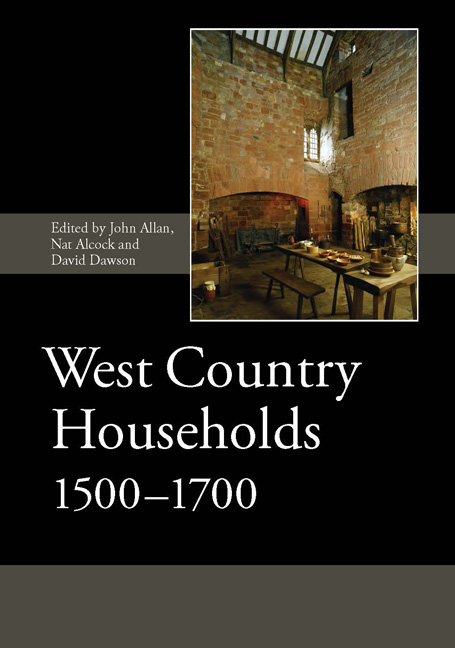Book contents
- Frontmatter
- Dedication
- Contents
- List of Illustrations
- List of Contributors
- List of Abbreviations
- Introduction
- I The Form and Development of West Country Houses
- II The Decoration of West Country Houses
- III The Material Culture of West Country Households
- 10 Culinary Artefacts in West Country Households, 1550–1700: Form, Function and Nomenclature
- 11 The Archaeology of the West Country Bronze Foundries
- 12 Cast Bronze Cooking Pots in England, 1500–1720
- 13 Table Glass in the West Country Home, c. 1500–1700
- 14 Portuguese Faience in South-West England
- 15 Dinner on the Ceiling: the 17th-Century Plasterwork at 144 Fore Street, Exeter
- 16 Pots and Texts: Understanding Pots in Use
- 17 Presenting an Elizabethan Interior: the Reinterpretation of St Nicholas Priory, Exeter
- Index of People and Places
- Index of Subjects
15 - Dinner on the Ceiling: the 17th-Century Plasterwork at 144 Fore Street, Exeter
from III - The Material Culture of West Country Households
Published online by Cambridge University Press: 05 May 2015
- Frontmatter
- Dedication
- Contents
- List of Illustrations
- List of Contributors
- List of Abbreviations
- Introduction
- I The Form and Development of West Country Houses
- II The Decoration of West Country Houses
- III The Material Culture of West Country Households
- 10 Culinary Artefacts in West Country Households, 1550–1700: Form, Function and Nomenclature
- 11 The Archaeology of the West Country Bronze Foundries
- 12 Cast Bronze Cooking Pots in England, 1500–1720
- 13 Table Glass in the West Country Home, c. 1500–1700
- 14 Portuguese Faience in South-West England
- 15 Dinner on the Ceiling: the 17th-Century Plasterwork at 144 Fore Street, Exeter
- 16 Pots and Texts: Understanding Pots in Use
- 17 Presenting an Elizabethan Interior: the Reinterpretation of St Nicholas Priory, Exeter
- Index of People and Places
- Index of Subjects
Summary
The plasterwork ceiling of an Exeter house is interpreted as showing an apparently unique visual record of the manner in which tables were set out around 1680, with unusual evidence of the way in which dining chambers/parlours were used by prosperous urban families at this period. One setting is interpreted as a fish-day or Lenten meal, the other as sweetmeats presented at a banquet. It is suggested that they mirror the table settings laid out on oval tables which would have been eaten directly below them.
INTRODUCTION
In 1975 and 1995–6 John Thorp and Richard Parker of Exeter Museums Archaeological Field Unit made careful drawn and photographic records of the extraordinary limeplaster ceiling of 144 Fore Street, Exeter. The ceiling's major features are two oval tablesettings, one of fish, the other of fruit, each within a floral border surrounded by real and fabulous animals. Their design appears to be a unique depiction of a 17th-century English table-setting. This paper will discuss the culinary aspects of the various elements of the scheme and their bearing on the date and interpretation of the plasterwork.
No. 144 Fore Street is a house which occupies a long narrow tenement in one of Exeter's principal streets; it dates mainly from the late 17th century (Fig. 15.1). Reconstruction of the tenement history of the property by A.G. Collings showed that it had been owned and occupied from the 1630s to the late 1690s by the Somers family, leading figures in the city's important fulling trade; one of the family, Thomas Somers, was elected Master of the Company of Weavers, Fullers and Shearmen, the principal guild of Exeter's cloth industry, in 1695.
The principal element of the property is a block three storeys high and two rooms deep, standing on the street frontage; to the rear stood two ancillary buildings separated by two small courtyards.
- Type
- Chapter
- Information
- West Country Households, 1500–1700 , pp. 357 - 366Publisher: Boydell & BrewerPrint publication year: 2015



